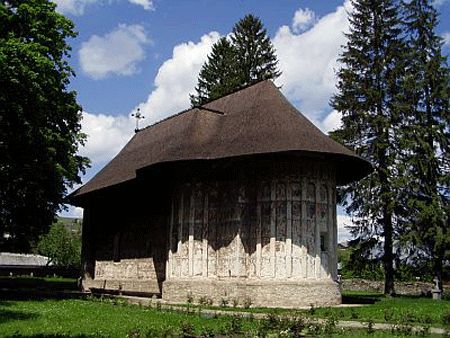Not far away from Gura Humorului, a small town, lies the Humor Monastery, in the village of the same name, a picturesque and very old place of worship and surely one of the most interesting and beautiful in Suceava country, dating way back from the Middle Ages. It is one of those Moldavian monasteries that somewhat looks like a fortress, with sturdy wall, wonderful architecture and amazing outside and inside paintings, a landmark in the region and a recommended place to visit.

According to historians and an inscription above the entrance the church was founded in 1530 by a boyar, Toader Bubuiog, in the times of Petru Rares. Together with his wife, Anastasia, Toader wanted to provide the peasants a new place of worship, a church that was his way of praising the Lord, but in the end decided that a monastery would be a far better idea. The location chosen for the future chosen was next to the ruins of a former chiech, which was abandones somewhat in the middle of the previous century, for reasons unknown. The builders chose for the Humor monastery the same traditional style, paying close attention to the degree and variety of decorations, some of the paintings being made by a mysterious Toma, which according to the signing was originary from Suceava.
The altar and other interior decorative and worship elements were made out of wood, wonderfully carved and sometimes painted, and like many other churches in Moldova - such as Sucevita, Voronet, Arbore and the likes - all paintings were wonderful frescoes, in Byzantine style, depicting saints, religious scenes, major moments in the life of Jesus, Bible elements. It is one of the few churches where the care for the aspect of the paintings was mixed with the great attention to detail, and together with the wonderful condition in which they were preserved, it is a work of part. Purely a work of art. It is more than fortunate that such a work of art was preserved for all to see today how good the old painters were.
Interesting is the series of representations inside the church, most of them images of major moments in the Tradition of the Church, such as the Assumption of the Mother of God, several beautiful old icons, portraits of hermits, angels, saints, martyrs. It seems that the artist from so many centuries ago was particularly impressed by the figure of the Mother of God, for many scenes from her life have found their way on the walls of the church. Also, visitors of today can see the portraits of the founders of the church, and it is a strange sensation to think that they lived so many, many years ago. Of special interest is also the scene of the Last Supper on the inside of the church.
Exiting the church, art lovers can see the reasonable well preserved outside paintings, adorning the exterior walls, the most easily recognisable and best being, without a doubt, The Last Day of the Judgment, a complicated, detailed and rather frightening depictions. Also, due to the time and age, there is also a scene of the Constantinople's Siege, the struggle between Christian and Ottoman armies being somewhat of a symbol.
The Humor Monastery in the Suceava county must be visited by all who are interested into finding out more about the past and sacred art of the region, and also want to visit key landmarks.

































